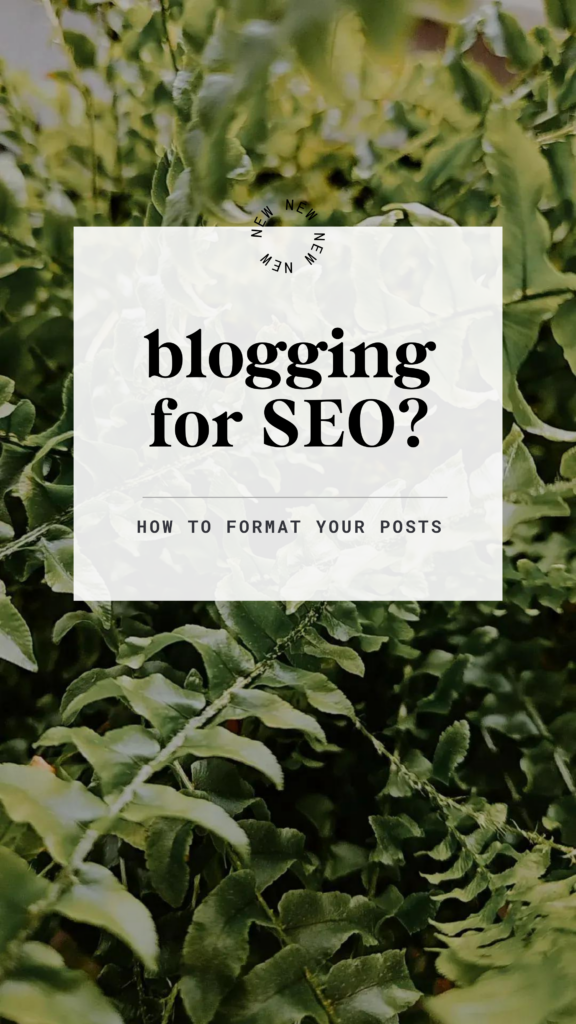Blogging for SEO? How to Format Your Posts
If you have a blog, you have knowledge that you’d like to share — but if you’re blogging for SEO, it’s much more than just random content that you’re spewing out into the world.
Did you know that your average website has less than 10 chances to rank on Google, while a website with a blog has no limits? Pretty cool, right?
That’s because every blog post is an opportunity to target a specific keyword or phrase — which lets you reach more people, share your expertise, and drive growth for your business!
We have clients who approach us all the time with gobs of inspiring and informative content, and that’s incredible! But it will go unnoticed if it’s not optimized for search engines. That’s a whole lotta time / money spent with zero results, and that’s a bummer.
To make sure that your content (blog, social media, or otherwise!) is actually WORKING for your business, you need to make sure that you’re creating it intentionally and formatting it in a way that search engines can pick up.
That’s where SEO comes in! It’s a science AND an art to make your content discoverable online. (And quite frankly, it’s one of our very favourite things.) When you understand the fundamentals of SEO and applying them to your blog posts, you can boost your visibility, attract more organic traffic, and of course, grow your audience and business. 💪
In this post, we’ll explain the essential SEO strategies tailored for wellness / lifestyle / service based businesses. We will also nerd out a little on how to conduct effective keyword research, optimize your blog posts for search engines, and FINE… we’ll use social media too, to amplify your reach.
Oh, and if all of this is going to make you want to light your hair on fire before you even start (🤣), we gotchu! You can hire us to write and optimize your posts… get the details right here!
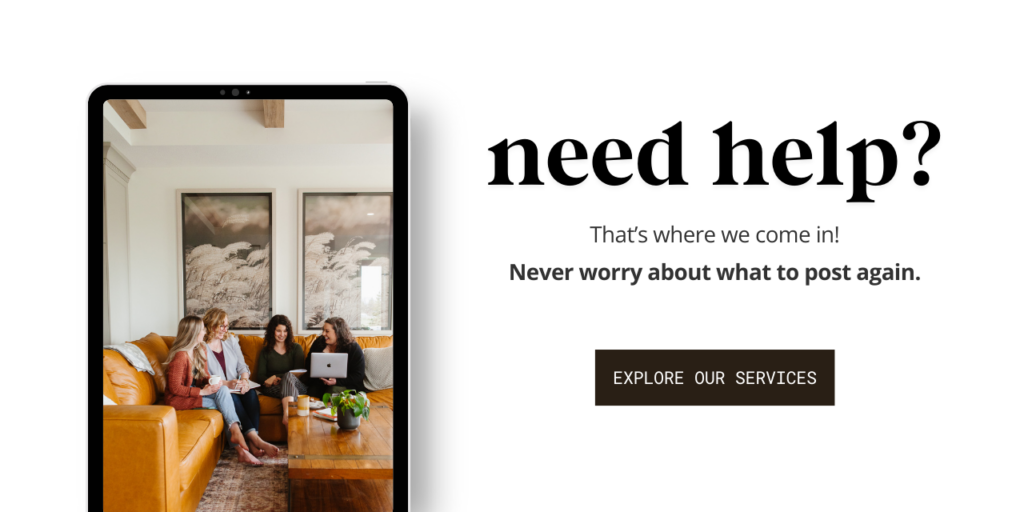
Ready to take your content to the next level? Let’s dive in!
Table of Contents
Part 1: Blogging for SEO 101
So, what is SEO?
It sounds fancy, right? SEO stands for search engine optimization — in a nutshell, it’s making sure you format your content in a way that search engines (and humans!) can pick up on the other side. When you nail your SEO, you get more eyes on your stuff… which is something that every business owner wants!
A well-optimized blog post can:
- Attract more organic traffic: This means more people will find your content without you having to pay for advertising. According to Backlinko, organic search drives 53% of all website traffic.
- Boost your brand’s visibility: A strong online presence can help establish your authority in your niche.
- Improve user experience: SEO best practices often align with user experience principles, ensuring your readers have a smooth and enjoyable experience.
- Provide long-term benefits: While it may take time to see results, the benefits of SEO can be long-lasting.
Keywords: The Most Important Part of Blog SEO
Keywords are the words and phrases people use to search for information online. By understanding and incorporating relevant keywords into your blog posts, you can make your content more visible to your target audience.
- Short-tail keywords: These are broad, general terms like “wellness blog” or “lifestyle tips.”
- Long-tail keywords: These are more specific, like “natural remedies for stress relief for women over 50.”
👉 Not sure where to start with keyword research? We have some posts about that!
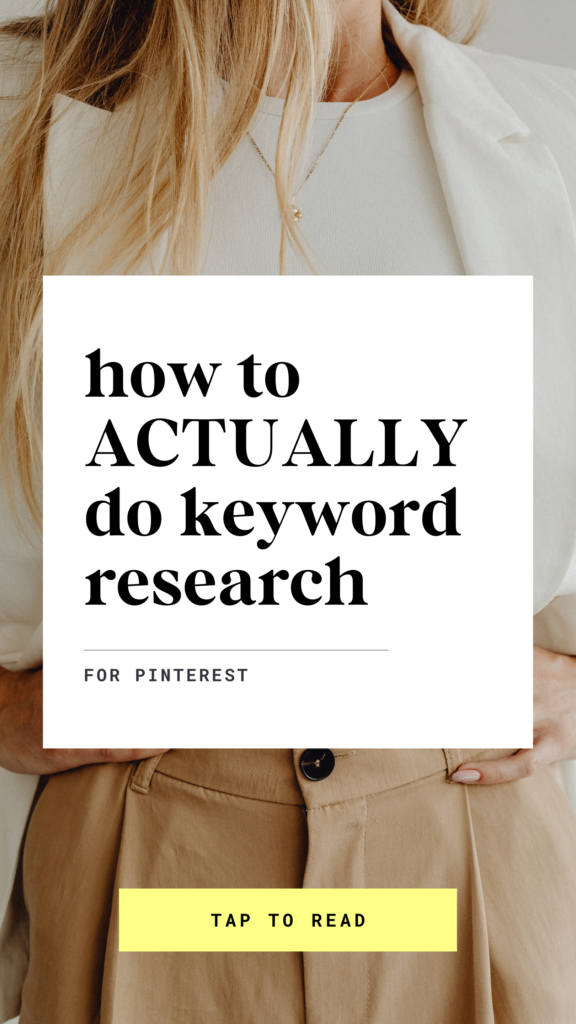
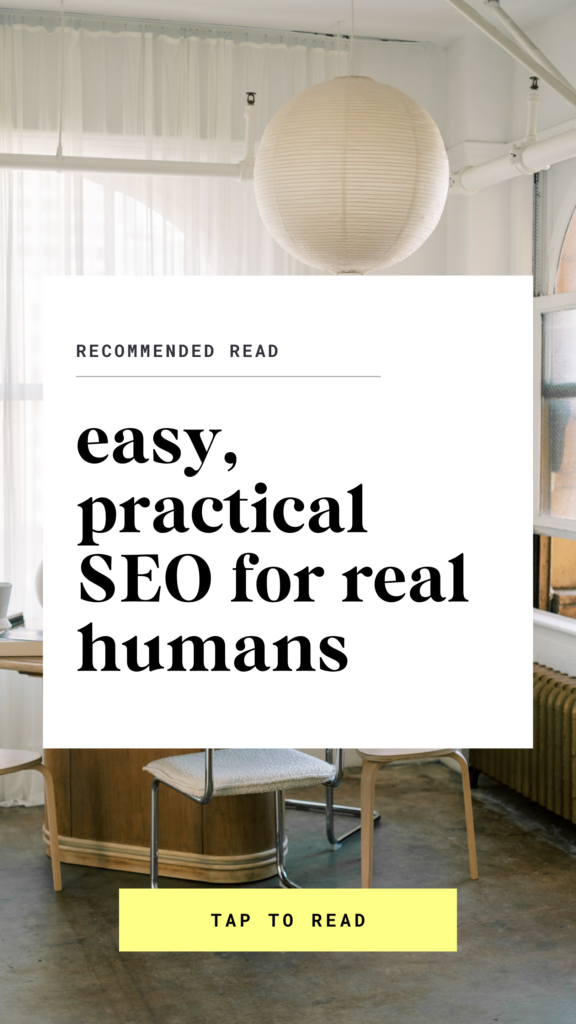
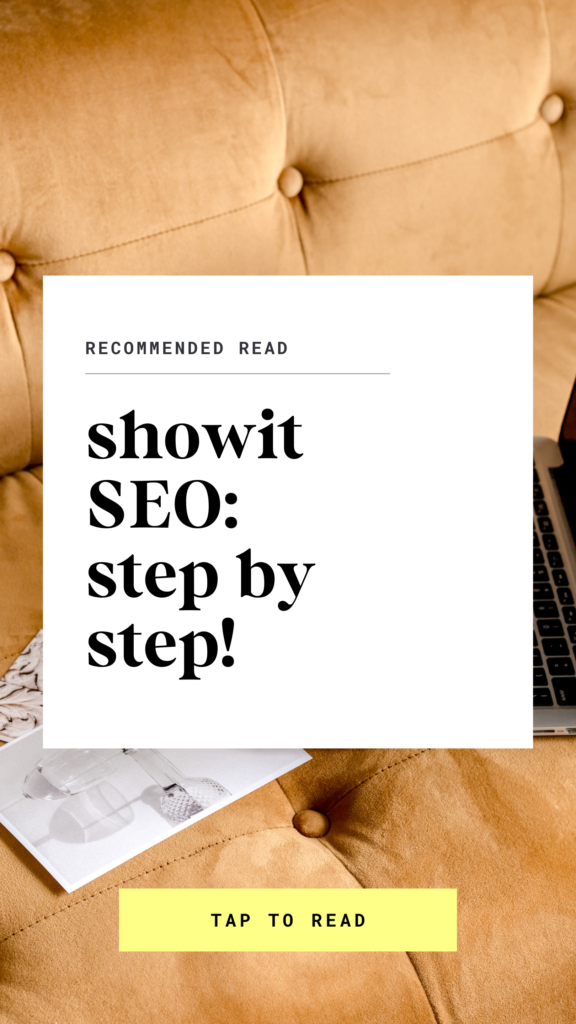
In the next section, we’ll dive deeper into the practical steps you can take to optimize your blog posts for search engines!

Part 2: Optimizing Your Blog Posts for Search Engines
Now that you have a basic understanding of SEO, let’s dive into the practical steps you can take to optimize your blog posts!
On-Page SEO: The Technical Stuff
Remember how we said SEO is an art AND a science? This is the science part — and it’s actually pretty easy!
This is literally a checklist… and if you’re using Showit / WordPress, you can install a plugin that’ll step you through all of this and then some. (Scroll to the bottom of this post if you want our recommendations!)
- Title Tags: These are the clickable headlines that appear in search engine results. A strong title tag should be concise, informative, and include your target keyword.
- Meta Descriptions: These are the brief descriptions that appear below title tags in search results. Write compelling meta descriptions that accurately describe your content and entice clicks.
- URL Structure: Keep your URLs clean, concise, and keyword-rich. Avoid using special characters and excessive hyphens.
- Header Tags: Use header tags (H1, H2, H3, etc.) to structure your content. Your main heading (H1) should include your target keyword.
If you’ve got a Showit site, make sure that you or your designer labelled this properly on the back end!
First, log into your Showit account and select the Single Post page in the left panel. Then head to the right panel and go to the ‘SEO Settings’ tab. Select your page title, then go to the right panel, select the ‘Text Properties’ tab, and under the ‘Advanced’ section, set the appropriate tag.
Most of these tags will pre-populate if you have your type styles set up correctly. This is what you’re looking for! 👇 Your blog post title should be labelled as “H1.”
Pssst… when we design your site, this will all be set up for you and you won’t have to think twice. Peep our website design services here!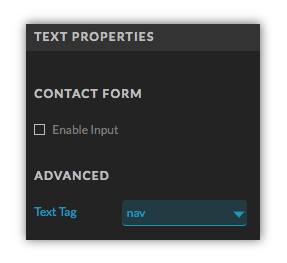
- Image Optimization: Optimize your images by compressing them for faster loading times and adding descriptive alt text that includes relevant keywords.
- Internal and External Linking: Link to other relevant posts on your website (internal linking) and authoritative external websites (external linking). This helps establish context and improves your website’s authority. You see us doing this here ALL the time — including in this blog post!
Content Quality and Keyword Placement
- Keyword Density: While it’s important to include your target keyword throughout your content, don’t overdo it. Aim for a natural keyword density, focusing on quality over quantity.
- Readability and User Experience: Write clear, concise, and well-structured content that is easy to read and understand.
- Long-Tail Keywords: Incorporate long-tail keywords into your content to target specific audience segments and reduce competition.
By following these tips, you’ll be well on your way to boosting your blog’s visibility and attracting more readers. Next up, we’ll dive into how social media can help you reach even more people!
Part 3: Recommended Plugins
If you have or are considering a Showit website, you’ll be blogging on the WordPress platform — which is known for having robust SEO capabilities! (We know. It’s confusing. Just go with it. It’ll make sense later. 🤣)
- Yoast SEO: EVERYBODY recommends this one — but honestly, it’s not our fave. That said, it’s a popular and comprehensive SEO plugin that offers a wide range of features, including keyword optimization, readability analysis, and social media integration. They really work hard to upsell you to the paid version, but the free one will do the job for basic SEO!
- Rank Math: Our favourite! It’s got everything that the Yoast plugin offers, but it’s easier to use. It also provides advanced features like AI-powered content optimization (honestly, we haven’t used this part) and schema markup (YES PLZ for us nerds). Pretty cool!

Part 4: How to Repurpose Your Blog Posts on Social Media
Social media is a fantastic way to share your blog posts with the world — and the best part is, when you’re blogging it’s WAYYYYY less work to show up consistently on social.
Plus, social media signals can influence up to 10% of search engine rankings… and that’s only going to go up in the years to come! (Source: Backlinko)
Regularly post your blog posts on your social media channels. You can straight up link to them, but you can also grab little snippets and share those on social media.
When we create blog posts for you, every section of the post can be turned into a single social media post — plus, there’s usually a summary at the bottom that can stand alone as a post too. Easy peasy!
Example: We just turned this blog post on how to generate more leads from your website into a five part series on Instagram! Took about 20 min to pull it all together. EVERYTHING in this grid was pulled directly from our website and blog.
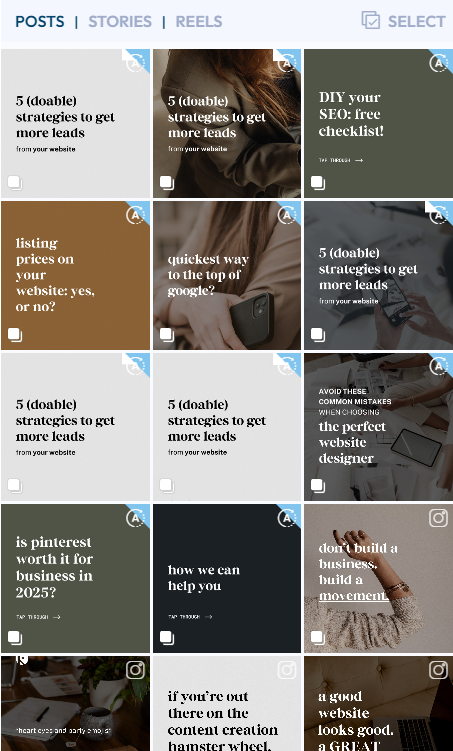
Now there’s some social media content we can really get behind. (The best part? We can recycle the exact same content in 6 months and it’ll still be relevant.) By using social media strategically — and, y’know, SUSTAINABLY, you can reach more people, grow your audience, and share your amazing content with the world!
tl;dr
Blogging isn’t just about sharing your thoughts and expertise — it’s a powerful tool to grow your business and reach a wider audience. When you have a good grasp on the basics of SEO and apply ’em to your blog posts, you can boost your visibility, attract more organic traffic, and achieve your business goals! Remember, SEO isn’t done in a day. It’s about consistent effort and continuous improvement.
Biggest takeaways:
- Keyword research is a huge part of making sure that your SEO efforts are worth your time. Identify relevant keywords to target your ideal audience.
- On page SEO is a great start, but blogging is going to take your search engine visibility to the next level. Create high quality content that’s helpful for your readers.
- Social media can still be a part of your marketing strategy! Derek Halpurn, an experienced internet marketer, recommends that we spend 20 percent of our time creating content and 80 percent promoting it. (Source) Um, yeah, we’re all guilty here. Get it out there!
